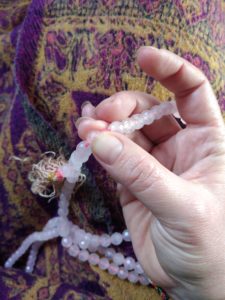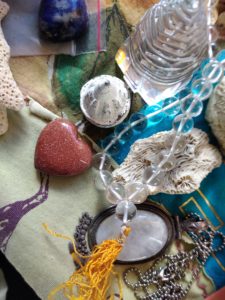My new recordings of Mantra Meditation are available this winter on Bandcamp!
To let you know a bit more about the practice I am sharing the benefits of Ajapa Japa for you. This meditation technique is popular because there are many tools to focus on. The breath, visualisation of the pathway of the breath and the mantra. For this reason it is easier to stay on track. Using the audio you are guided through the practice. If the mind drifts or gets distracted it can be gently guided back to the technique.
Japa means the continuous repetition of a mantra. When the suffix ‘A’ is added the meaning changes to the spontaneous repetition of the mantra. With regular practice of this meditation technique the mantra will repeat itself spontaneously without conscious effort.
The method of mantra meditation traced back to the Yoga Upanishads dating between 100 BC and 1100 AD. In the Higashiosaka Upanishad it is stated that the sound ‘So’ goes with the in breath and ‘Ham’ with the out breath. It is this mantra ‘So Ham’ that is commonly used in Ajapa Japa meditation.
Benefits of Ajapa Japa:
- Releases mental tension thus removing the cause of most mental and physical ailments
- Creates peace and calm in the mind

How to hold a mala
- Through the repetition on the mantra pranic energy is vitalised
- Has been found to reduce hypertension, fever and anxiety
- Can lead a person to the higher states of meditation
- Safe for everyone to practice
- By-passes the analytical process
- It is a pratyahara practice (sense withdrawal) that can lead to deeper states of meditation
- Visualisation of the breath in Sushumna Nadi activates the energy in the chakras
- If practised sincerely and regularly it will bring hidden desires, fears and complexes of the mind to the surface where they can be observed and released
Swami Satyananda says that,
‘Ajapa Japa is a complete sadhana in itself which can take an aspirant from the most elemental level of body and environmental awareness to the highest stages of meditation.’
Elements of the practice
Ajapa Japa combines Ujjayi pranayama (victorious breath), awareness of the frontal or spinal pathway of the chakras and mantra, in this case So-ham.
Ujjayi pranayama is performed by slightly constricting the glottis in the throat so that the inhale makes a slightly snorey or oceany sound. The exhale is a relaxed exhale. It takes some practice to master this breath. The sound should just be audible to you. This breath is calming and soothing for the mind.
In stage one and three the breath is visualised moving up and down the frontal passage from the naval to the throat and then the naval to the third eye respectfully. In stage two the awareness is of the breath within the spine. The pranic energy flows with our breath and our awareness activating the chakras and sushumna nadi (the central passage within the spine that Kundalini Shakti rises through).
The mantra So-ham is a universal mantra meaning that it can be used by anyone. A personal mantra is one that is given to a student by their Guru and must not be shared with others. So-ham is a simple mantra correlating to the sound of the breath. Literally it means ‘I am that,’ referring to the timeless universal energy.
If you have a personal mantra and would like to use it for this practice once you are confident with the sequence you can meditate independently without and audio using your mantra, Longer mantras such as the Gayatri can also be used.
How to practice
When learning the practice it is useful to be guided in the practice so that your mind can relax and not question if it is doing the meditation correctly. Sit in a comfortable position. You may sit on the floor with some cushions under the buttocks if you are an experienced meditator. Elevating the hips like this helps to avoid back pain. You can also choose to sit in a chair or sit against a wall on the floor with cushions lifting the hips. Start with a position that you feel you will be able to maintain throughout the practice.

Sumeru
Using a Mala
If you have a mala (similar to rosary beads) you can turn one bead for each mantra of so-ham. Hold the mala between the thumb, middle and ring fingers. You can either rest the hand on the knee or hold the mala close to your heart. It is best to avoid the mala touching the ground as it is a sacred item that you are infusing with your energy. It is important to not cross the sumeru which is the last bead from which the tassel emerges from because it is considered bad luck.
How often should I meditate?
It is recommended to meditate regularly opposed to sitting just once for a long time. Start by using an audio and then practice without the audio for 10 minutes per day. You can then increase your sit by 5 minutes each week until you reach a length of meditation that you can maintain easily and feels beneficial for you.
Downloading the Audio
Guided meditations are available on Bandcamp as an album with Stages 1-3 of Ajapa Japa plus 3 Yoga Nidras. This album is available for the season of winter/summer (depending on which side of the equator you are on!). New audios will be available next season. I hope you enjoy! You can always contact me with any questions or for more guidance.

Recent Comments